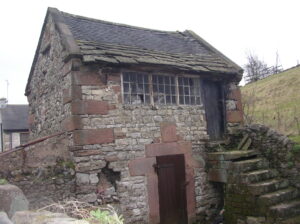Bonsall Framework Knitters workshop in Bonsall Dale dated 1737 above the door lintel.
The knitting frames developed by William Lee were too expensive for individual knitters to afford thus entrepreneurs hired out the frames to homes based knitters or ‘stockingers’. They also provided raw materials and paid the stockingers to deliver finished products to the warehouses.
Bonsall had 143 cotton frames operating in 1844.
from Bonsall Conservation Area Appraisal re Bonsall Framework Knitters workshop –
Alternative means of employment were to be found within the textile mills established by Arkwright at Cromford and mills along the Via Gellia. With the arrival of the Arkwright factories, Bonsall established itself as an important centre for framework knitting creating cottage industries, predominantly manufacturing stockings and other forms of hosiery on machines mounted on sturdy wooden frames. This type of industry originated
from around 1589 when the ‘stocking-frame’ was invented by the Reverend William Lee (Nottingham). The Derby Rib machine, patented in 1759 by Jedediah Strutt, was a modification of this, which enabled ribbed stockings and gloves to be made. The original frame design remained until well into the 19th century. Framework knitting was carried out mainly in cottages and small workshops. The hosiers (many from Belper), rented out the machinery and also supplied raw materials usually cotton but sometimes silk. It was also the hosier who purchased the final products. By 1844, 143 frames were recorded at Bonsall and it was one of the largest centres of the industry.
Buildings used for framework knitting are distinguishable by their long horizontal windows, usually on the upper floors, behind which stood the machines. Workshops for framework knitting are still evident in Bonsall, one adjacent to Yew Tree Farm is listed Grade II, in recognition of its unique
history and an unlisted example on the slope above the Cross in the centre of Bonsall, housed six knitting frames and was still in use into the 20th century. The development of the limestone quarries and associated haulage as well as farming, all continued to provide employment throughout the
20th century.

